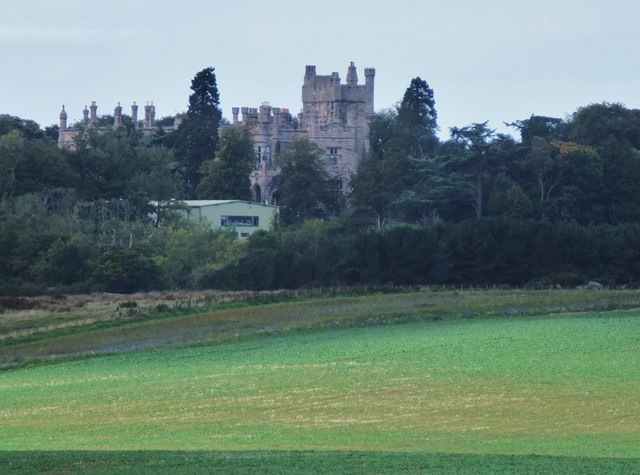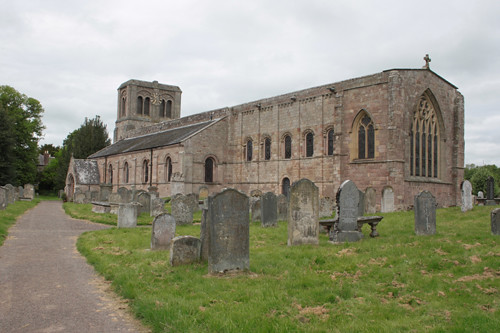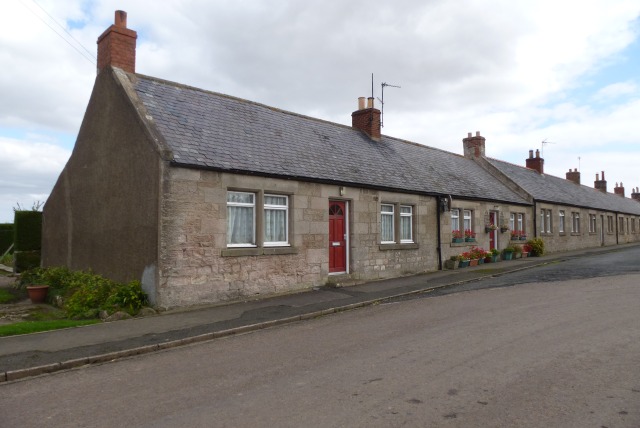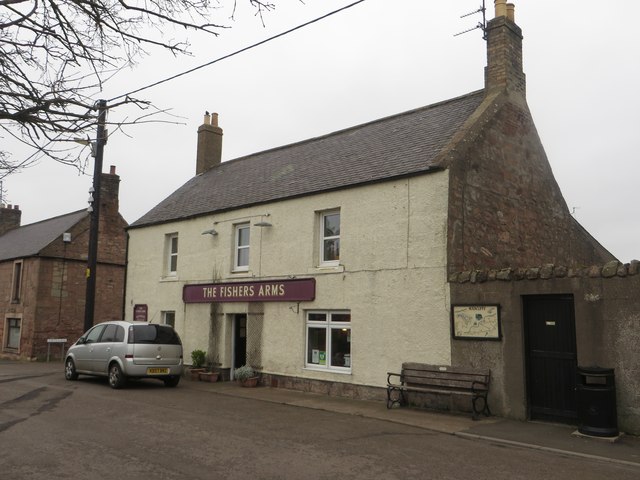Topics > Northumberland > Civil Parishes in Northumberland > Norham Civil Parish > Norham Parish, 1848
Norham Parish, 1848
NORHAM, or Norhamshire (St. Cuthbert), a parish, in the union of Berwick-upon-Tweed, N. division of Northumberland; containing 2,934 inhabitants, of whom 902 are in the township of Norham, 7 miles (S.W. by W.) from Berwick. The doctrines of Christianity are stated to have been first preached to the Northumbrians, by the Scottish missionaries, at Norham; and on the establishment of a see for Northumbria, this place was given to Aidan, the first bishop. It continued in the possession of his successors until the time of Bishop Barnes, who alienated his rights to the crown: the bishops exercised a special jurisdiction throughout the district, having their sheriff, coroner, justices, and other civil officers, their court of exchequer, gallows, &c. Being situated on a pass or ford on the river Tweed, called Ubbanford, upon the borders of England and Scotland, Norham was frequently the scene of rapine and bloodshed, and the place of meeting between the principal officers of the two kingdoms for settling affairs relative to the border. Bishop Flambard, in 1121, probably erected the first regular fortress. Having been enlarged and strengthened by succeeding prelates, the castle, when well garrisoned, was deemed almost impregnable. David I., King of Scotland, however, in 1138 took and destroyed the town and fortress after a spirited resistance; but they were rebuilt in 1154, by Bishop Pudsey, who erected the present great tower of the castle, and conferred extensive privileges by charter on the inhabitants.
Various treaties between the Scots and King John were arranged here; and in 1215, that monarch, in consequence of the defection of the Northumbrian barons, and their having sworn homage to the Scottish king (Alexander II.), laid siege to the castle, which held out successfully for forty days, when he was obliged to withdraw his forces. In 1318, it was unsuccessfully besieged by the Scots, who, however, were more fortunate in an attack in 1322; they then obtained possession of it, but were soon afterwards compelled to abandon the prize, after having for ten days resisted an assault of Edward II. Upon the accession of Edward III., they stormed the castle with success, and retained it a short time. The town was plundered and burnt in 1355, by a party of Scottish troops, under the command of Sir William Ramsay; in 1498 the castle was besieged by the Scottish monarch himself, but the Earl of Surrey advancing to the relief of the garrison, the assailants were compelled to retire. Just before the battle of Flodden-Field the Scots again invested the fortress, which fell into their hands through information given by a deserter from the garrison. The remains of this strong edifice occupy the summit of a steep rocky eminence impending over the river, and so near that portions have been washed away by the stream; the keep or main tower, with its vaults and prisons entire, is the principal part, and is constructed of a soft red freestone.
The parish consists of the townships of Duddo, Felkington, Grindon, Horncliffe, Loan-End, Longridge, Norham, Norham-Mains, Shoreswood, Thornton, and Twizel. It comprises by computation 14,000 acres: the soil is various; the substratum abounds with coal, of which several mines are in operation, and there are some quarries of stone, raised for ordinary building purposes. Here is a considerable salmon-fishery; and fairs take place on the second Thursday in May, and the third Thursday in October. A market was formerly held, but it has been long discontinued. The living is a vicarage, valued in the king's books at £15. 6. 8., and in the gift of the Dean and Chapter of Durham, who are likewise appropriators: the vicarial tithes have been commuted for £460, and the glebe comprises 24 acres. The church, built about 1180, comprises only part of the original edifice, the tower and aisles having been rebuilt in 1837, and a north and south transept in 1838; it had anciently three chantries in honour of St. Cuthbert, the Blessed Virgin Mary, and St. Nicholas, and possessed the privilege of sanctuary for thirty-seven days. The remains of Ceolwulph, a lineal descendant of Ida, and King of Northumbria, were brought from Lindisfarne and buried at Norham, where also Gospatric, Earl of Northumberland, was interred. There is a place of worship in connexion with the United Secession Synod of Scotland; also a free school, originally founded in 1762, and rebuilt in 1809, and which is endowed with about twenty acres of land, producing an annual income of £36. About two miles below Norham, on the banks of the river Tweed, two urns containing human bones have been found in a gravel-pit called the Crooks, near which are the pedestals of two ancient crosses, also an artificial eminence, probably a barrow, surrounded by stone steps. There are some Druidical remains, and vestiges of a Roman camp. The learned Dr. George Carleton, successively Bishop of Llandaff and of Chichester, who died in 1628, was born here.
Extract from: A Topographical Dictionary of England comprising the several counties, cities, boroughs, corporate and market towns, parishes, and townships..... 7th Edition, by Samuel Lewis, London, 1848.

Co-Curate Page
Shoreswood Township, 1848
- SHORESWOOD, a township, in the parish of Norham, union of Berwick-upon-Tweed, N. division of Northumberland, 6½ miles (S.W. by S.) from Berwick; containing 315 inhabitants, chiefly employed in the adjacent …

Co-Curate Page
Thornton Township (Norham), 1848
- THORNTON, a township, in the parish of Norham, union of Berwick-upon-Tweed, N. division of Northumberland, 5¼ miles (S.W.) from Berwick; containing 178 inhabitants. This place was the manor and residence …

Co-Curate Page
Twizell Township (Norham Parish), 1848
- TWIZELL, a township, in the parish of Norham, union of Berwick-upon-Tweed, N. division of Northumberland, 10 miles (S.W.) from Berwick; containing 336 inhabitants. It is situated on the river Till, …

Co-Curate Page
Felkington Township, 1848
- FELKINGTON, a township, in the parish of Norham, union of Berwick-upon-Tweed, N. division of Northumberland, 14½ miles (N. by W.) from Wooler; containing, with Grievestead, 141 inhabitants. The manor once …

Co-Curate Page
Duddo Township, 1848
- DUDDO, a township, in the parish of Norham, otherwise Norhamshire, union of Berwick-upon-Tweed, N. division of Northumberland; containing 276 inhabitants. It comprises by computation 1,650 acres, of which 1,420 are …

Co-Curate Page
Loanend Township, 1848
- LOAN-END, a township, in the parish of Norham, otherwise Norhamshire, union of Berwick-uponTweed, N. division of Northumberland, 4½ miles (W.S.W.) from Berwick-upon-Tweed; containing 155 inhabitants. The township comprises 824¾ acres, …

Co-Curate Page
Longridge
- Overview Map Street View The hamlets of Longridge Towers and West Longridge in Northumberland are located close to the border with Scotland, about 3 miles south-west of Berwick-upon-Tweed. The large …

Co-Curate Page
Norham
- Overview About Norham Map Street View Norham is a village in Northumberland, which is located just south of the River Tweed near the border with Scotland. It is the site …

Co-Curate Page
Grindon, near Berwick
- Overview Map Street View Grindon is a hamlet in Northumberland, located near the border with Scotland, about 2 miles south-east of Norham and 7 miles south-west of Berwick-on-Tweed. There are …

Co-Curate Page
Horncliffe
- Overview Map Street View Horncliffe in Northumberland is the most northerly village in England. It is situated on the south bank of the River Tweed, which forms the border with …


Co-Curate Page
Shoreswood Township, 1848
- SHORESWOOD, a township, in the parish of Norham, union of Berwick-upon-Tweed, N. division of Northumberland, 6½ miles (S.W. by S.) from Berwick; containing 315 inhabitants, chiefly employed in the adjacent …

Co-Curate Page
Thornton Township (Norham), 1848
- THORNTON, a township, in the parish of Norham, union of Berwick-upon-Tweed, N. division of Northumberland, 5¼ miles (S.W.) from Berwick; containing 178 inhabitants. This place was the manor and residence …

Co-Curate Page
Twizell Township (Norham Parish), 1848
- TWIZELL, a township, in the parish of Norham, union of Berwick-upon-Tweed, N. division of Northumberland, 10 miles (S.W.) from Berwick; containing 336 inhabitants. It is situated on the river Till, …

Co-Curate Page
Felkington Township, 1848
- FELKINGTON, a township, in the parish of Norham, union of Berwick-upon-Tweed, N. division of Northumberland, 14½ miles (N. by W.) from Wooler; containing, with Grievestead, 141 inhabitants. The manor once …

Co-Curate Page
Duddo Township, 1848
- DUDDO, a township, in the parish of Norham, otherwise Norhamshire, union of Berwick-upon-Tweed, N. division of Northumberland; containing 276 inhabitants. It comprises by computation 1,650 acres, of which 1,420 are …

Co-Curate Page
Loanend Township, 1848
- LOAN-END, a township, in the parish of Norham, otherwise Norhamshire, union of Berwick-uponTweed, N. division of Northumberland, 4½ miles (W.S.W.) from Berwick-upon-Tweed; containing 155 inhabitants. The township comprises 824¾ acres, …

Co-Curate Page
Longridge
- Overview Map Street View The hamlets of Longridge Towers and West Longridge in Northumberland are located close to the border with Scotland, about 3 miles south-west of Berwick-upon-Tweed. The large …

Co-Curate Page
Norham
- Overview About Norham Map Street View Norham is a village in Northumberland, which is located just south of the River Tweed near the border with Scotland. It is the site …

Co-Curate Page
Grindon, near Berwick
- Overview Map Street View Grindon is a hamlet in Northumberland, located near the border with Scotland, about 2 miles south-east of Norham and 7 miles south-west of Berwick-on-Tweed. There are …









